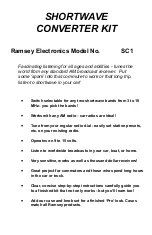
Fabricator 181i
BASIC WELDING GUIDE
4-14
Manual 0-5191
The Welder
Place yourself in a comfortable position before beginning to weld. Get a seat of suitable height and do as much
work as possible sitting down. Don't hold your body tense. A taut attitude of mind and a tensed body will soon
make you feel tired. Relax and you will find that the job becomes much easier. You can add much to your peace of
mind by wearing a leather apron and gauntlets. You won't be worrying then about being burnt or sparks setting
alight to your clothes.
Place the work so that the direction of welding is across, rather than to or from, your body. The electrode holder
lead should be clear of any obstruction so that you can move your arm freely along as the electrode burns down.
If the lead is slung over your shoulder, it allows greater freedom of movement and takes a lot of weight off your
hand. Be sure the insulation on your cable and electrode holder is not faulty, otherwise you are risking an electric
shock.
Striking the Arc
Practice this on a piece of scrap plate before going on to more exacting work. You may at first experience difficulty
due to the tip of the electrode "sticking" to the work piece. This is caused by making too heavy a contact with the
work and failing to withdraw the electrode quickly enough. A low amperage will accentuate it. This freezing-on of
the tip may be overcome by scratching the electrode along the plate surface in the same way as a match is struck.
As soon as the arc is established, maintain a 1/16"(1.6mm) to 1/8"(3.2mm) gap between the burning electrode
end and the parent metal. Draw the electrode slowly along as it melts down.
Another difficulty you may meet is the tendency, after the arc is struck, to withdraw the electrode so far that the
arc is broken again. A little practice will soon remedy both of these faults.
Art # A-10368
1/16" (1.6mm)
Figure 4-20: Striking an Arc
Arc Length
The securing of an arc length necessary to produce a neat weld soon becomes almost automatic. You will find
that a long arc produces more heat. A very long arc produces a crackling or spluttering noise and the weld metal
comes across in large, irregular blobs. The weld bead is flattened and spatter increases. A short arc is essential
if a high quality weld is to be obtained although if it is too short there is the danger of it being blanketed by slag
and the electrode tip being solidified in. If this should happen, give the electrode a quick twist back over the weld
to detach it. Contact or "touch-weld" electrodes such as E7014 Stick electrodes do not stick in this way, and make
welding much easier.
Rate of Travel
After the arc is struck, your next concern is to maintain it, and this requires moving the electrode tip towards the
molten pool at the same rate as it is melting away. At the same time, the electrode has to move along the plate to
form a bead. The electrode is directed at the weld pool at about 20º from the vertical. The rate of travel has to be
adjusted so that a well-formed bead is produced.
If the travel is too fast, the bead will be narrow and strung out and may even be broken up into individual globules.
If the travel is too slow, the weld metal piles up and the bead will be too large.
Making Welded Joints
Having attained some skill in the handling of an electrode, you will be ready to go on to make up welded joints.
Содержание FABRICATOR 181i
Страница 6: ......
Страница 24: ......
Страница 30: ......
Страница 58: ...Fabricator 181i INSTALLATION OPERATION AND SETUP 3 28 Manual 0 5191 ...
Страница 91: ...Fabricator 181i Manual 0 5191 5 7 Trouble Shooting and Service ...
Страница 92: ...Fabricator 181i Trouble Shooting and Service 5 8 Manual 0 5191 This page is left blank intentionally ...
Страница 94: ...Fabricator 181i KEY SPARE PARTS 6 2 Manual 0 5191 6 02 Power Source Art A 11243_AB Figure 6 2 31 ...
Страница 96: ...Fabricator 181i KEY SPARE PARTS 6 4 Manual 0 5191 This page is left blank intentionally ...
















































